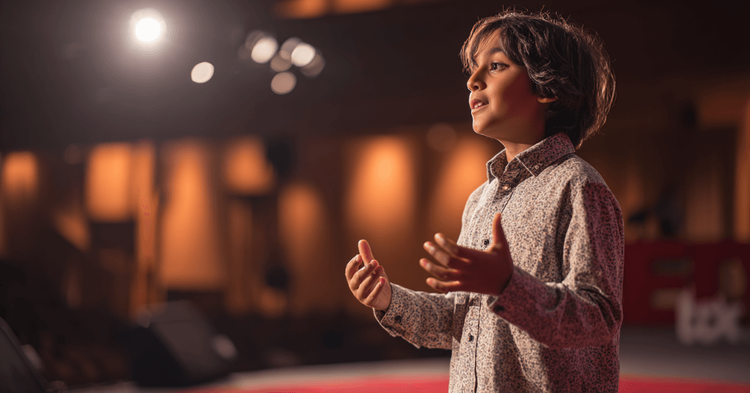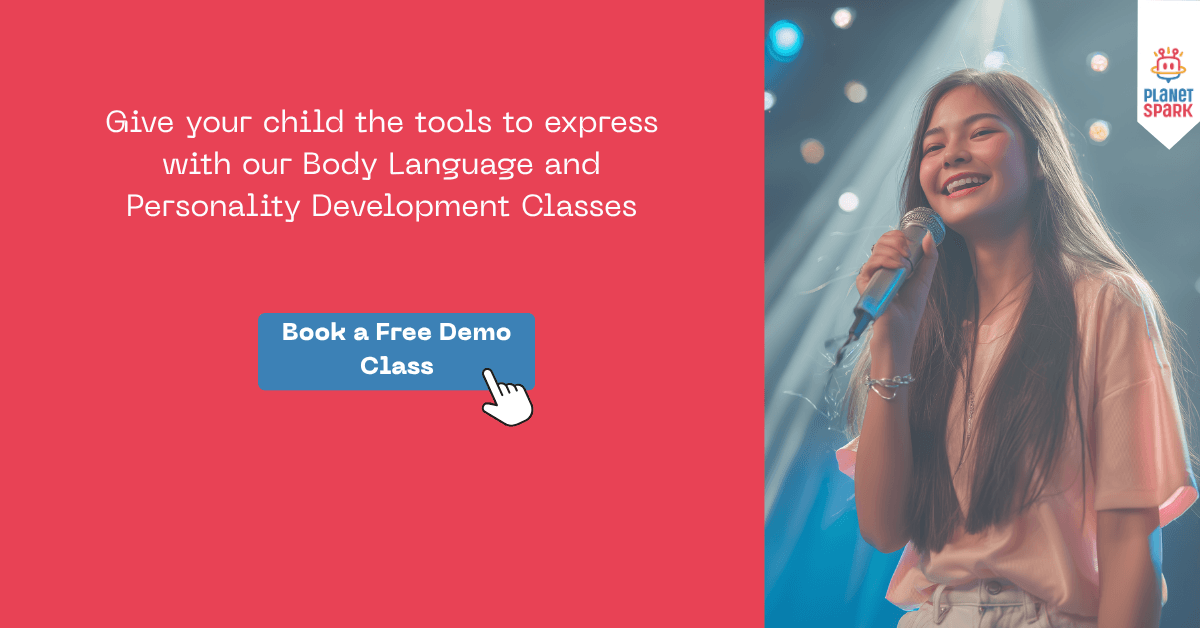How to Improve Body Language: A Guide to Build Confidence

Table of Contents
Body language is a silent superpower! Even before you say a single word, your body starts communicating with the people around you. For kids, learning good body language isn't just about looking confident it's about feeling confident too. In this blog, we’ll explore everything you need to know about improving body language from why it matters to easy ways to practice it.
At PlanetSpark, we believe that strong body language builds stronger personalities. That’s why we train kids through fun, interactive public speaking and personality development sessions that unlock their full potential.
Why Is Body Language Important?
Body language is a big part of how we communicate. Experts say more than 70% of communication is non-verbal. That means how you look, move, and react can say more than the words you speak.
For kids, mastering body language helps in:
- Building self-confidence
- Making a great first impression
- Speaking more effectively in class or on stage
- Showing respect and attentiveness
- Becoming a better leader and listener
PlanetSpark’s programs focus on exactly these skills through the art of storytelling, role-play, extempore, and mock interviews, children practice using confident body language naturally.
How to Improve Body Language: 7 Elements
Let’s break it down into fun, simple parts. Here are the seven key elements of body language that every child can practice:
Posture: Stand Tall Like a Tree
A straight back, chin up, and shoulders back not only makes you look confident, but also helps you feel strong from within. Whether sitting or standing, good posture shows that you’re ready to listen and speak.
Eye Contact: Use Your Super Eye Power
Looking into someone’s eyes while talking shows honesty, confidence, and interest. It tells your teacher or friend that you are paying attention.
Facial Expressions: Let Your Face Talk
Smiling, nodding, or raising your eyebrows when something is surprising these small expressions make your speech exciting and your feelings clearer.
Hand Gestures: Show It with Your Hands
Gestures make your words more lively. Moving your hands to show size, shape, direction, or emotion helps your audience follow along. Teach your kids the art of using the gestures to be a good communicator.
Movements: Walk with Confidence
How you walk on stage or into a classroom matters. Walk with your head up, eyes forward, and a gentle smile. Avoid dragging your feet or hunching.
Tone of Voice: Add Life to Your Words
Though not technically "body language," your tone is closely tied to your physical expression. Speak clearly and vary your pitch to keep your listeners interested.
Space and Distance: Respect Personal Boundaries
Knowing how much space to keep while talking shows respect and confidence. Don’t stand too close or too far.
Want your child to master these essential body language skills and become a confident communicator?
Enroll them in PlanetSpark’s Online Public Speaking Classes where posture, gestures, tone, and stage presence are taught step-by-step by expert coaches!
Book a Free Trial Class Today
Fun Body Language Activities for Kids
Learning body language should be fun! Here are a few activities kids can do at home or with friends to become better communicators:
- Mirror Practice: Stand in front of a mirror and give a one-minute speech. Watch your hands, face, and posture. Are you expressive? Confident?
- Gesture Charades: Play charades using only gestures and facial expressions. This builds awareness of non-verbal communication.
- Emotion Switch: Say the same sentence with different emotions happy, angry, sad, surprised. Learn how your face and body change with each.
- Freeze and Speak: Walk around freely, and when someone says “freeze,” deliver a line or sentence from that frozen position. It's silly but teaches control and awareness
- This is not the end of our list, check here for some more tips on body language training for children.
How PlanetSpark Helps Kids Improve Body Language
At PlanetSpark, we don’t believe in boring lectures. We help kids build communication skills through live, interactive, and personalized sessions.
- 1:1 Public Speaking Coaching: Each child gets focused attention from communication experts trained in child psychology. We give personalized feedback on body language, expressions, and stage presence.
- Step-by-Step Skill Building: From storytelling and speech structuring to debates and persuasive techniques our curriculum includes body language as a key component.
- Real-Time Practice with Global Peers: Kids perform live with other students from over 13 countries! They learn to manage stage fear and body movement naturally.
- Video Feedback Loop: We record kids' performances and review them with coaches highlighting posture, gestures, and expressions to improve with each session.
- Personality Grooming Sessions: Our personality development program teaches eye contact, etiquette, self-presentation, and even mock interviews to shape future-ready leaders.
How Good Body Language Boosts Personality
Body language doesn’t just help on stage it shapes your personality. When children use strong body language, they also build:
- Leadership Skills – Walking confidently and addressing groups becomes second nature.
- Self-Awareness – Understanding how you’re seen by others helps improve behavior.
- Empathy and Respect – Facial expressions help kids connect emotionally with others.
- Social Etiquette – Learning when to smile, nod, or keep distance improves social intelligence.
- Join Online Classes – The best way to build strong non-verbal skills is through guided, expert-led training. Join online classes for body language for kids to make it easy and engaging for your child from the comfort of your home.
Great body language builds great personalities!
Help your child develop leadership, confidence, and charm with PlanetSpark’s Personality Development and Body Language Classes for Kids Online.
Enroll Now for a free demo classs & see the transformation
Tips for Parents to Support Body Language Practice
As a parent, you can play a big role in helping your child develop body language skills. Here are a few ideas:
- Watch & Learn Together: Watch TED Talks or speeches with your child and discuss the speaker’s posture, gestures, and expressions.
- Celebrate Small Wins: Praise your child when they maintain eye contact, speak with good posture, or use expressive hand gestures.
- Be a Role Model: Use confident body language in your own communication they’ll learn by watching you.
- Create Performance Time: Set up mini-speaking sessions at home where your child can present, recite, or tell stories.
Sample Script for Kids to Practice Body Language
Here’s a short 30-second speech your child can use to practice body language at home:
“Hi everyone! My name is Aarav. I love playing football and reading mystery books. One of my favorite characters is Sherlock Holmes because he always thinks smartly. I want to become a detective one day too! Thank you!”
Practice this in front of a mirror using:
- Eye contact
- Natural hand movements
- A smile
- Confident tone
- Good posture
Conclusion
Body language is one of the first steps to building confidence and a strong personality in kids. By learning to use posture, gestures, eye contact, and tone effectively, children can become not just better speakers but better leaders, thinkers, and friends.
At PlanetSpark, we help your child grow into the best version of themselves through interactive training, fun exercises, and expert coaching. Whether your child is shy or already expressive, our classes are designed to bring out their spark.
FAQs: How to Improve Body Language
Q. My child is shy. Can body language training help?
A. Yes. Confident body language can slowly reduce shyness and boost self-esteem through positive reinforcement and practice.
Q. What activities help improve body language at home?
A. Storytelling, mirror practice, role-playing, and charades are excellent ways to improve body awareness.
Q. How long does it take to see improvement?
A. Many students show visible improvement within a few weeks. With regular practice and feedback, confidence and clarity grow steadily.
Personalized Communication Report
Record a video to get a AI generated personalized communication report for your child

Hi There, want to try these
tips for your child with
LIVE with our expert coach?
Let's check your child's
English fluency

